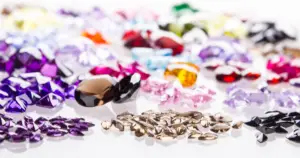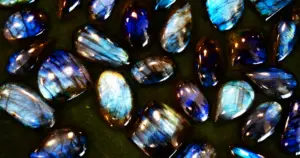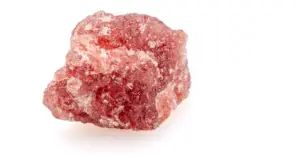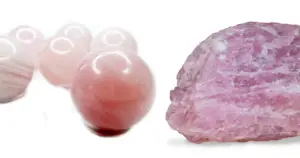How to Tell if Lapis Lazuli is Real Or Fake in 6 Easy Ways
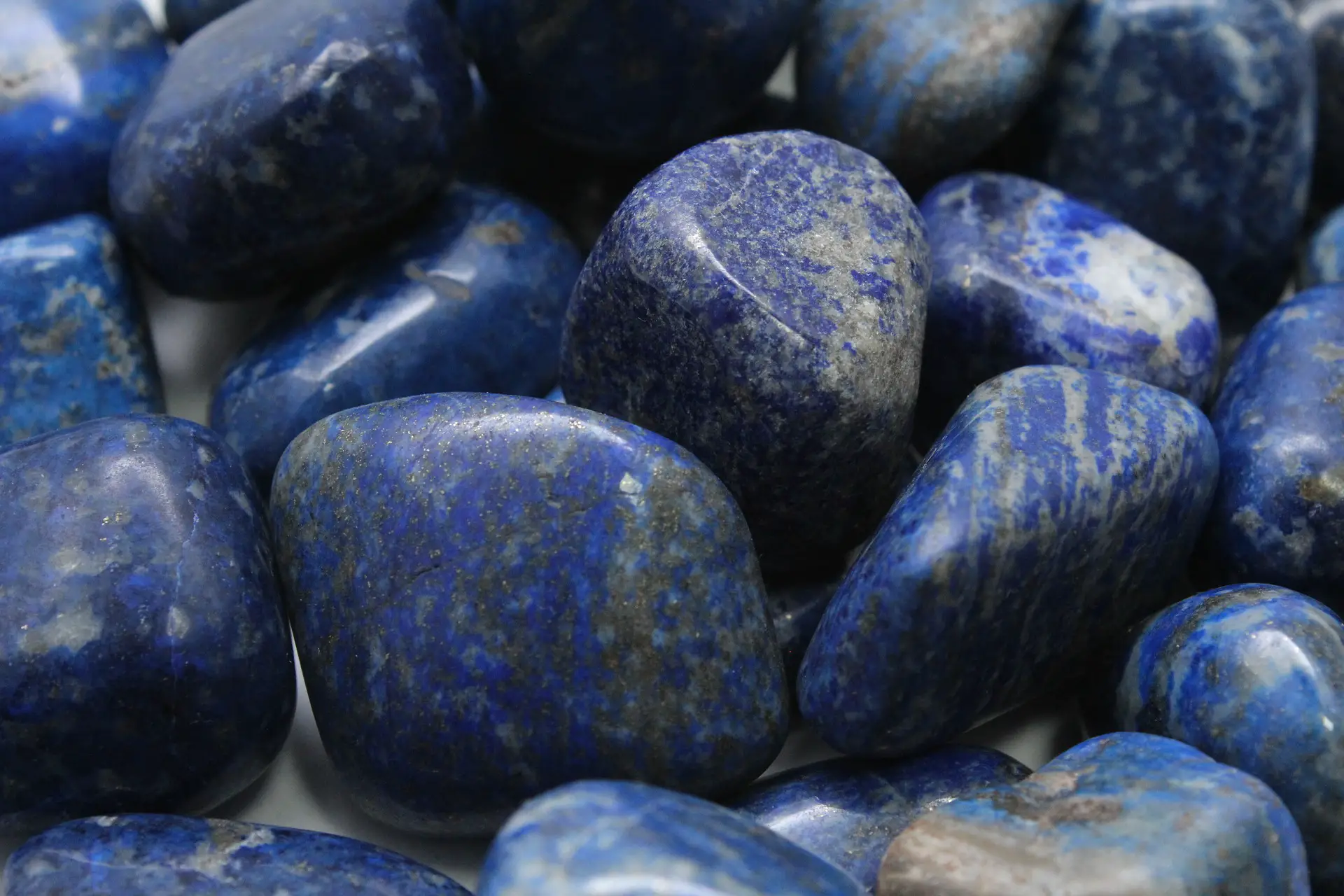
Lapis have been highly prized throughout history because ancient people thought these shining veins were actual gold (later discovered to be iron pyrite, or “fool’s gold”). Read to know how to tell if Lapis Lazuli is Real or Fake.
The gemstone known and marketed as Lapis Lazuli, or simply Lapis, is indeed a rock composed of three significant minerals from the sodalite family: lazurite, hallyne, and nosean, which lend it its characteristic rich blue color.
Suggested Reading: What are The Top 3 Negative Effects of Lapis Lazuli?
Calcite and pyrite in various percentages are also present in the rock, which often appear as veins and spots of gold on its surface.
When buying a tone as historically prized as Lapis, a thorough understanding of the chemical and material properties of the stone can help you segregate real stones from fakes.
Can Lapis Lazuli Go in Water? Is Lapis Lazuli Water Safe? Read here.
Table of Contents
How to Tell if Lapis Lazuli is Real or Fake?
Run a Streak Test
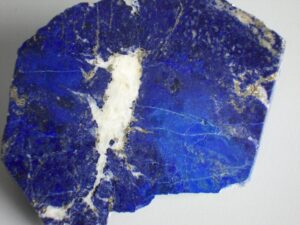
The value of Lapis Lazuli is contingent almost exclusively on the kind and richness of ultramarine coloration it shows.
The finest Lapis is considered to be a solid, deep blue with no white calcite spots and just a sprinkling of brassy yellow pyrite.
If you are buying and paying the price compared to what is being marketed as a top-quality stone, make sure that it occurs with a deep uniform blue (sometimes tinged with a violet), and the surface is free of white calcite veining and virtually free of more tolerable, aesthetically appealing golden pyrite flecks.
- The highest quality Lapis is found only in Afghanistan and Pakistan, in commercially viable quantities. Colorado is also a site of sprawling, high-grade Lapis production, limited severely in quantity. Make sure to ask your seller about the place of origin of your stone to ascertain its quality.
- One foolproof but slightly destructive way to ensure that the pigmentation of your stone is natural is to conduct a streak test. To conduct a streak test, you need a porcelain tile and your rock.
- Scratch the sharp edge of your rock against the tile. A real Lapis should leave a blue streak. If your rock scratched the tile with a white line or not at all, you can be assured that it is a fake.
Observe the Polish on the Stone
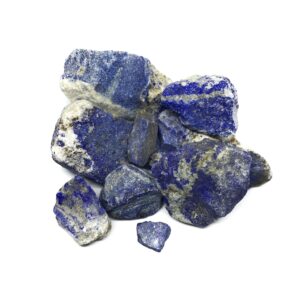
In the gemstone grading world, the bluer a Lapis, the more value it has. Some Lapis lovers, however, like their stones to show pyrite inclusions, which occur as golden streaks on the surface of the blue.
The quest for perfectly ultramarine Lapis has resulted in an inundation of synthetically dyed varieties of glass and laboratory duplications of the stone, which are easier to sell as high-grade gemstones.
A naturally occurring Lapis, even when it is perfectly blue, will never be physically perfect in that it will occur either with lighter shades of an even blue, slight to mild color zoning of darker blues, or, perhaps, some surface cracks.
If the cut and surface of your stone are identical throughout, with no visible sign of fractures, it is a fake. Fake Lapis are produced in large blocks and therefore look perfectly cuboidal when cut.
Another way to avoid such and other garden-variety imitations is to observe the polish of your stone closely.
Lapis is renowned for its ability to withstand great abuse and accept a clean polish, despite a low hardness of 5-6.
Since stones vary in hardness, and a mineral’s hardness directly bears the kind of polish a stone can take, a poor polish is typically evidence of a softer mineral.
What Does Lapis Lazuli Do? 7 Interesting Facts, Read here.
Check for the Specific Gravity
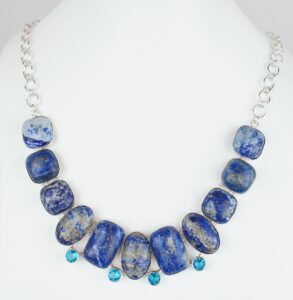
Sodalite, a semi-precious stone that ranges from a grey-blue to deep blue color, is occasionally sold as lapis lazuli. Sodalite is a component of Lapis and can be beautiful in its own right but typically of much lesser value. Having said that there are some signification differences between Lapis and Sodalite.
If the stone you are looking at is of a darker blue-grey coloring without any swirls of white or flecks of gold, there is a chance it is Sodalite.
Even more pesky to Lapis buyers are blue calcite-veined sodalites (properly, but hardly ever, called hackmanites) from places like America, Canada, Greenland, and Norway. Costing next to nothing, these Lapis look-alikes can fool the unwary. And no wonder. Both stones belong to the same rock family, sodium aluminum silicate.
Suggested reading: Hackmanite Meaning: Healing Properties, Benefits and Uses
To make matters worse, sodalite laps up the dye as readily as most of its more expensive next of family.
Fortunately, Sodalite gives itself away by its lower specific gravity-2.24, versus 2.75 of the natural Lapis, which your jeweler can easily test.
So if your Lapis resembles Sodalite more closely than other minerals, ask your jeweler to conduct a gravity test.
Conduct an Acetone Test

Another variety of imitations, which chemically still qualify as Lapis, but are of cheap quality, are those stones that may be dyed in spots, but never in their entirety, to conceal small patches of calcite.
Despite waxing to seal in color additives, dyes used in Lapis are unstable, especially if exposed to household chemicals such as acetone. Perspiration, perfumes, and cosmetics also pose a constant threat to the color of dyed Lapis beads.
To identify if your Lapis is dyed, you can rub a cotton swab dipped in acetone on the surface of your rock. If the pigmentation gives way to rubbing acetone, it is a telltale sign of cheap dyes.
Sometimes even licking a suspect Lapis with the tongue and then wiping the stone on a piece of tissue paper will leave a tell-tale blue streak.
In any case, have your merchant put in writing that your stones are natural and undyed.
Observe how it Interacts with Light
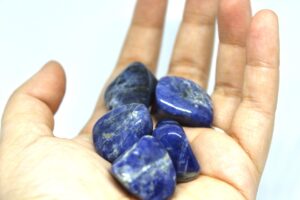
Real Lapis has a dull luster, which means that when held under diffused light, like sunlight or any other white light, the surface does not glow or look glossy because it absorbs more light than it reflects.
This is a good identifier against imitations such as glass, plastic, or resin, which mostly have an incredibly vitreous luster; they appear shiny, almost glass-like under light.
Read on to know about how to Identify a Real Lapis lazuli from a Fake one.
Conduct Chemical Tests
This is for beginner mineral enthusiasts and hobbyists who can access chemicals and are willing to destroy their stones.
One distinct chemical feature of Lapis is that it reacts with hydrochloric acid to release hydrogen sulfide, which produces a pungent rotten-egg odor.
You can conduct such a test only in a controlled environment with some caution by putting a drop of Hydrochloric acid on the surface of your stone. If it reacts to produce a sewer smell, you can be assured that it is a naturally occurring Lapis variety.
Few Benefits of Lapis
- Lapis has several benefits. Lapis’ extensive mythological and historical footprints are a testament to its versatility; treasured for its beauty across civilizations for at least 6,000 years, from Biblical references to use as a pigment in Greco-Roman art to the adornments in the mask of King Tutankhamun.
- Due to its sturdy nature and ability to take an excellent polish, Lapis has been used for several centuries in amulets, beads, scarabs, seals, crowns, girdles, breastplates, rings, and necklaces due to its sturdy nature and ability to take an excellent polish and earrings.
- In addition, it has been inlaid in altars, temples, and facades. Ancient priests have recorded using it medicinally since it was believed to bring serenity, cure melancholy, improve eye conditions, and was considered a worthy gift for kings.
Final Thoughts
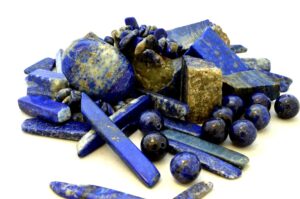
You can begin by observing the coloration and inclusions present in your stone. You can supplement this by conducting a streak test to confirm the originality of the blue Lapis pigment.
In this article, we have offered a list of ways that involve the immersion of visual, attentive, tactile, and olfactory resources to confirm the naturalness of your Lapis stone.
Also, make sure to observe the polish and luster on the gemstone, which are best tested in daylight.
Common chemical tests that can reveal fakes include the use of acetone, which, for dyed varieties, releases pigment, and hydrochloric acid, which reacts with real Lapis to produce an eggy smell.
While buying your stone from a jeweler, be sure to rely on your stone’s price and occurrence.
Most Lapis that exist in the market today come from Afghanistan rather than America. Sodalite, a common replacement stone, occurs more abundantly in America.
If you are being sold American Lapis stones, make sure to further clarify for its stone gravity, for it could most well be Sodalite.
